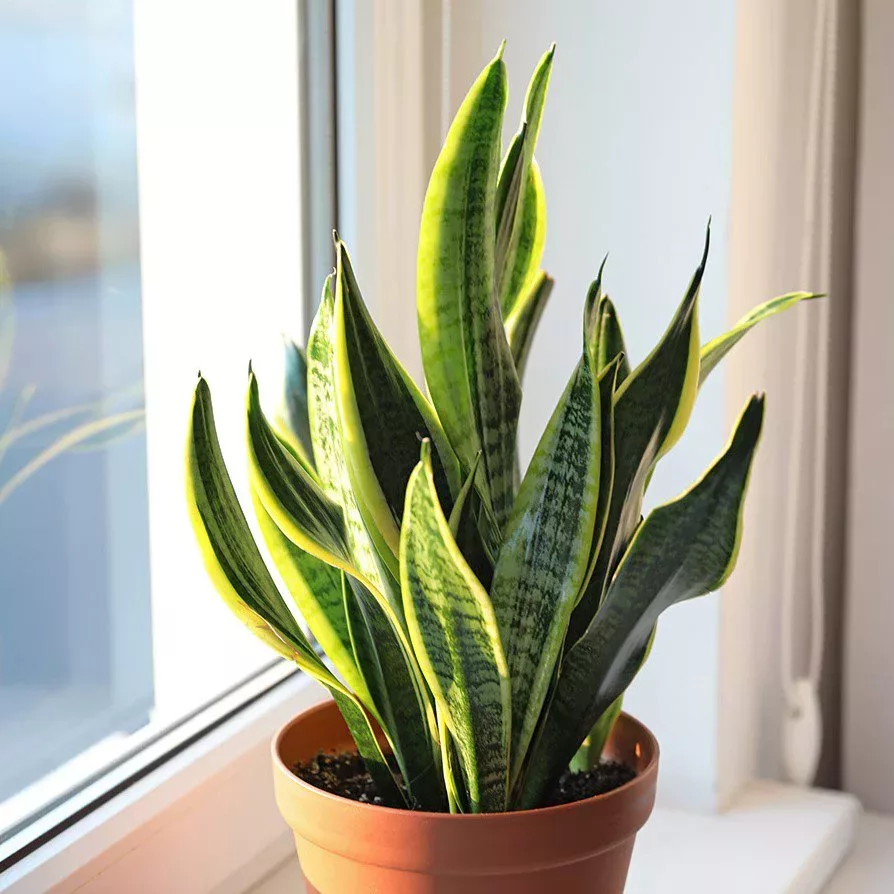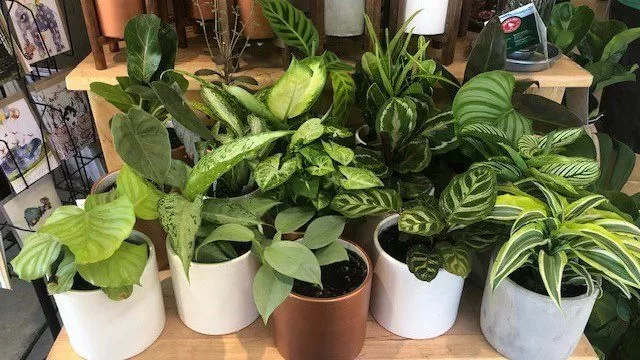Indoor plants are a joy. Studies show they reduce stress, improve focus and immunity, and have a measurable positive effect on indoor air quality. There’s no doubt that being surrounded life is beneficial to us, even if that life is a houseplant. But the world of plants is so broad and diverse, it can be an intimidating hobby to approach. Which plants need more light? Which need less water? Are my pets safe? Our aim is to shed some light on those questions and promote indoor plant care for all!

Philodendron “Birkin”
The Birkin is a gorgeous tropical plant, notable for its striking leaf patterns. It grows slowly and loves humidity, so mist it regularly or keep near other plants.
Water: Loves wet soil, water once a week or more if soil is drying out
Light: This plant thrives in indirect light. It prefers to sit in a room with a window, as long as it’s not right in front of it. If it’s not getting enough light, you’ll notice the brilliant white streaks on the leaves begin to turn a darker green.
Toxicity: The leaves of this plant are toxic to small animals and children, so keep in a safe place if your cat likes to chew on plant leaves.

Futura Superba “Snake Plant”
The Snake plant is noted for its resilience and beauty, surviving in a variety of conditions and sporting a gold trim on its broad leaves. It’s also particularly great for air quality, so keep a few around the house.
Water: Water less than most plants, allowing soil to dry out completely between waterings. This could be as little as once per month in low-light conditions.
Light: Prefers medium indirect light, but hardy enough to live in both high and low light.
Toxicity: The leaves are mildly toxic, so be sure to keep out of reach of pets and children.

Ficus Tineke “Rubber Plant”
The rubber plant is a popular ficus to keep around. It can grow up to 10 feet tall indoors. The leaves are noted for resembling watercolor on parchment.
Water: This plant prefers a bit of dryness from time to time. Let the first inch or two of soil dry out before watering again, usually about once every two weeks. Too much water can cause root rot, so lean toward underwatering if you’re not sure.
Light: The rubber plant bright but indirect light, mimicking an overgrown tropical forest. An east facing window will give you the best results, providing soft morning light while avoiding the harsh afternoon rays. Ideal conditions will reveal pink hues on the leaves.
Toxicity: The leaves of this plant are toxic to small animals and children, so keep in a safe place if your cat likes to chew on plant leaves.

Monstera Adansonii “Swiss Cheese Plant”
The Swiss Cheese plant is easy to spot. This one loves to climb, and in its natural habitat it will use nearby trees or vines to hoist up as it grows. Inserting a stake into the center of the pot will help it achieve its dreams. It also prefers high humidity, so bright bathrooms or rooms with humidifiers will help the Swiss Cheese plant thrive.
Water: Prefers consistent moisture, but try not to drench it. If the first inch of soil is starting to feel nearly dry, it’s time to add more water. Ideal watering will see a bit of water drain out from the pots holes at the bottom.
Light: Bright indirect light is key. If possible, place in the early sun a few hours a day and otherwise keep it out of direct light. If that isn’t possible, keep in a bright and humid room.
Toxicity: Like many tropical plants, the leaves contain calcium oxalate crystals, which can cause burning in the mouth if the leaves are chewed.

Aloe Vera
This plant resembles a desert cactus, but its leaves hold a secret. The juice from its leaves produces a wonderful topical medicine, good for burns, scrapes, and dry skin to name just a few of its benefits. Keep it near a kitchen window for frequent and easy use.
Water: Aloe Vera loves infrequent bursts of water. Let the soil dry out, but be sure to provide a healthy amount in between. Two to three weeks between watering is a good average to aim for.
Light: Prefers high light. Any bright area with periodic direct sunlight will cause this arid succulent to thrive.
Toxicity: Its leaves produce a natural healing gel, but be sure not to consume them, they can cause indigestion and are mildly toxic to small animals.
Find these plants and more in our floral department. We have more than 40 varieties, as well as the expertise to find something perfect for your home.
